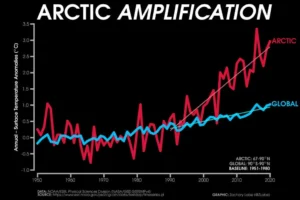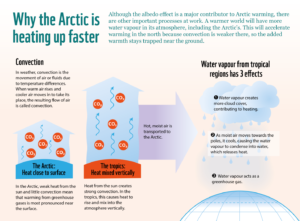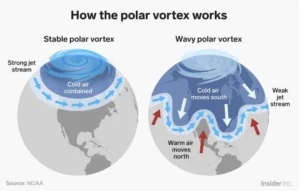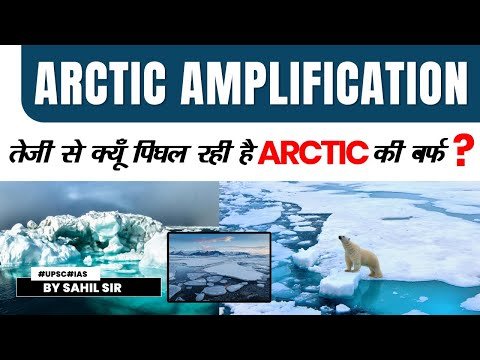Arctic Amplification: Causes, Effects, Solutions
- Context: While the Earth’s surface as a whole has warmed by around 1.2*C since the industrial revolution, temperatures are not rising at the same rate in all corners of the world.
- One difference is the faster pace that land areas are warming compared to the ocean. But perhaps the biggest outlier is the Arctic, which is warming more than two times faster than the global average.
- This phenomenon – known as “Arctic Amplification” –has also been linked to extreme weather events in the mid-latitudes of the northern hemisphere.

Analysis
Causes of Arctic Amplification
- Scientists have identified several factors driving this amplified warming in the Arctic region.
a) Loss of sea ice
- Ice is more reflective and less absorbent of sunlight than land or the surface of an ocean. When ice melts, it typically reveals darker areas of land or sea, and this results in increased sunlight absorption and associated warming.
-
-
- In more technical terms, losing sea ice reduces Earth’s albedo as ice has a much higher albedo than water.
-
-
-
- Albedo is the fraction of light that is reflected by a body or surface. The lower the albedo, the more a surface absorbs heat from sunlight rather than reflecting it back to space.
-
b) Absence of convection at higher latitudes
- One of the key reasons more warming occurs at high latitudes is the absence of convection at high latitudes.
- Convection occurs when air close to the ground is heated by the warm surface of the Earth. The warmed air is lighter than the cold air above and so starts to rise.
- In the tropics, the ground – and the air directly above it – is always heated by the sun, hence there is a lot of convection and the atmosphere is “well mixed” with so much rising air.
- At higher latitudes, the angle of solar radiation is smaller, causing energy to be spread over a larger area of the surface causing cooler surface temperatures which also means there is much less vertical mixing.
- The added warming from the CO2 and other greenhouse gases that humans have emitted generally heats the atmosphere most near the Earth’s surface.
- In the tropics, this extra warmth gets spread vertically due to convection. But in the Arctic, the warming from greenhouse gases is most pronounced near the surface.
c) Water Vapour
- Another key reason for amplified warming in the Arctic is the increase in transport of water vapour from the equator to the poles.
- The warm moist air from the tropics gets transported to the poles by the circulation of the atmosphere, and keeps the difference in temperature between the equator and the poles relatively small.
- As a warmer atmosphere can hold more moisture, we expect there to be more water vapour in the tropical atmosphere as global temperatures rise.
- This additional moisture gets transported to the poles, where it has a threefold impact on Arctic surface temperatures:
- First, water vapour itself acts as a greenhouse gas, contributing to additional warming.
- Second, as the moist air moves toward the poles, it cools, causing the water vapour to condense into liquid water, which releases heat into the atmosphere and further warms the region.
- Third, the increased moisture leads to more cloud cover, which tends to warm the Arctic.

d) Seasonal differences
- An additional important feature of Arctic amplification is that it occurs mostly in winter.
- This is mostly due to Arctic sea ice decline. Liquid water has a large “heat capacity” – it takes a long time to heat up and cool down.
- Hence when sea ice melts in summer and early autumn, it leads to an increase in sunlight absorbed by the Arctic ocean.
- This stored heat is then released in winter when there is no sunlight and the atmosphere is colder than the underlying Arctic ocean.
Effects of Arctic warming
a) More intense heatwaves
- The Arctic and Antarctic are the world’s refrigerator. Since they are covered in white snow and ice that reflect heat back into space, they balance out other parts of the world that absorb heat. Less ice means less reflected heat, meaning more intense heatwaves worldwide.
b) Weakening of polar jet stream
- One of the most significant effects of Arctic amplification is the weakening of west-to-east polar jet stream in the northern hemisphere.
-
-
- The polar jet stream is a concentrated pathway of air in the upper atmosphere which drives the weather patterns across the northern hemisphere.
-
- As the Arctic warms at a faster rate than the tropics, this results in a weaker atmospheric pressure gradient and hence lower wind speeds.
- The weakened jet stream meanders and brings the polar vortex further south, which results in more extreme winters in North America, Europe and Asia.

c) Increased circumpolar westerlies
- Global climate models project stronger surface warming in the Arctic than the Antarctic under climate change. But as the tropics continue to warm and expand, we may expect an increase in the pressure gradient between the tropics and Antarctica that will lead to increased circumpolar westerlies winds.
-
-
- The recent intensification and more poleward location of the southern hemisphere belt of westerly winds have been linked to continental droughts and wildfires, including those in Australia.
-
d) Effect on coastal communities
- Melting ice in polar regions and the rising seas endanger coastal cities and small island nations by exacerbating coastal flooding and storm surge. Glacial melt of the Greenland ice sheet is a major predictor of future sea level rise; if it melts entirely, global sea levels could rise 20 feet.
e) Effect on wildlife
- When there’s less sea ice, animals that depend on it for survival must adapt or perish. Loss of ice and melting permafrost spells trouble for polar bears, walruses, arctic foxes, snowy owls, reindeer, and many other species.
f) Permafrost
- Arctic ice and permafrost—ground that is permanently frozen—store large amounts of methane, a greenhouse gas that contributes to climate change. When it thaws, that methane is released, increasing the rate of warming. This, in turn, causes more ice and permafrost to thaw or melt, releasing more methane, causing more melting.
Why Arctic is warming faster than Antarctica
- The absence of convection and water vapour also affect Antarctica and lead to amplified Antarctic warming. In fact, the Antarctic continent has not warmed in the past seven decades, despite a steady increase in the atmospheric concentrations of greenhouse gases.
- However, polar amplification is much stronger in the Arctic than in Antarctica. This difference is because the Arctic is an ocean covered by sea ice, while Antarctica is an elevated continent covered in more permanent ice and snow.
- Also, amplified Antarctic warming is delayed due to the Southern Ocean circulation, which brings up cold water from the deep ocean and cools the surface.
Cutting Emissions is the best solution
- Cutting emissions can slow the rate of warming until the Earth’s temperature stabilizes when we reach net zero.
- But until we are able to remove more carbon dioxide from the atmosphere than we put in, the temperature will not go down.
- For this reason, there is increasing interest in so-called solar climate interventions—such as marine cloud brightening and stratospheric aerosol injection—that aim to cool the climate intentionally by increasing the amount of sunlight reflected to space.
- Note: The Earth has kept a record of its past climates, and scientists today can analyse various “proxies” – such as shells, stalactites (icicle-shaped formations that hang from the ceiling of a cave), pollen and seal pelts – to deduce the global climate going back many millions of years.
References:
- https://www.carbonbrief.org/guest-post-why-does-the-arctic-warm-faster-than-the-rest-of-the-planet/
- https://www.arcticwwf.org/the-circle/stories/why-is-the-arctic-warming-faster-than-the-rest-of-the-planet/
- https://council.science/current/blog/climate-explained-why-is-the-arctic-warming-faster-than-other-parts-of-the-world/
- https://www.worldwildlife.org/pages/six-ways-loss-of-arctic-ice-impacts-everyone#:~:text=Less%20ice%20means%20less%20reflected,bringing%20bitter%20cold%20with%20it.
Practice Questions:
Q1. Consider the following:
- Reducing albedo of the Arctic surface
- Absence of convection at higher latitudes
- Decrease in transport of water vapour from the equator to the poles
How many of the above correctly explain the phenomenon of amplified warming in the Arctic region than the other parts of the Earth?
- a) Only one
- b) Only two
- c) All three
- d) None
Mains Answer Writing Practice GS Paper 1
Topic: Salient features of World’s Physical Geography
- Evaluate the phenomenon of Arctic Amplification in the context of climate change, delineating its causes, assessing its environmental and geopolitical effects, and proposing viable solutions to mitigate its impact. (Answer in 250 words)
Note: The Model Answers to the above questions are available to the students of Tarun IAS free of cost.

